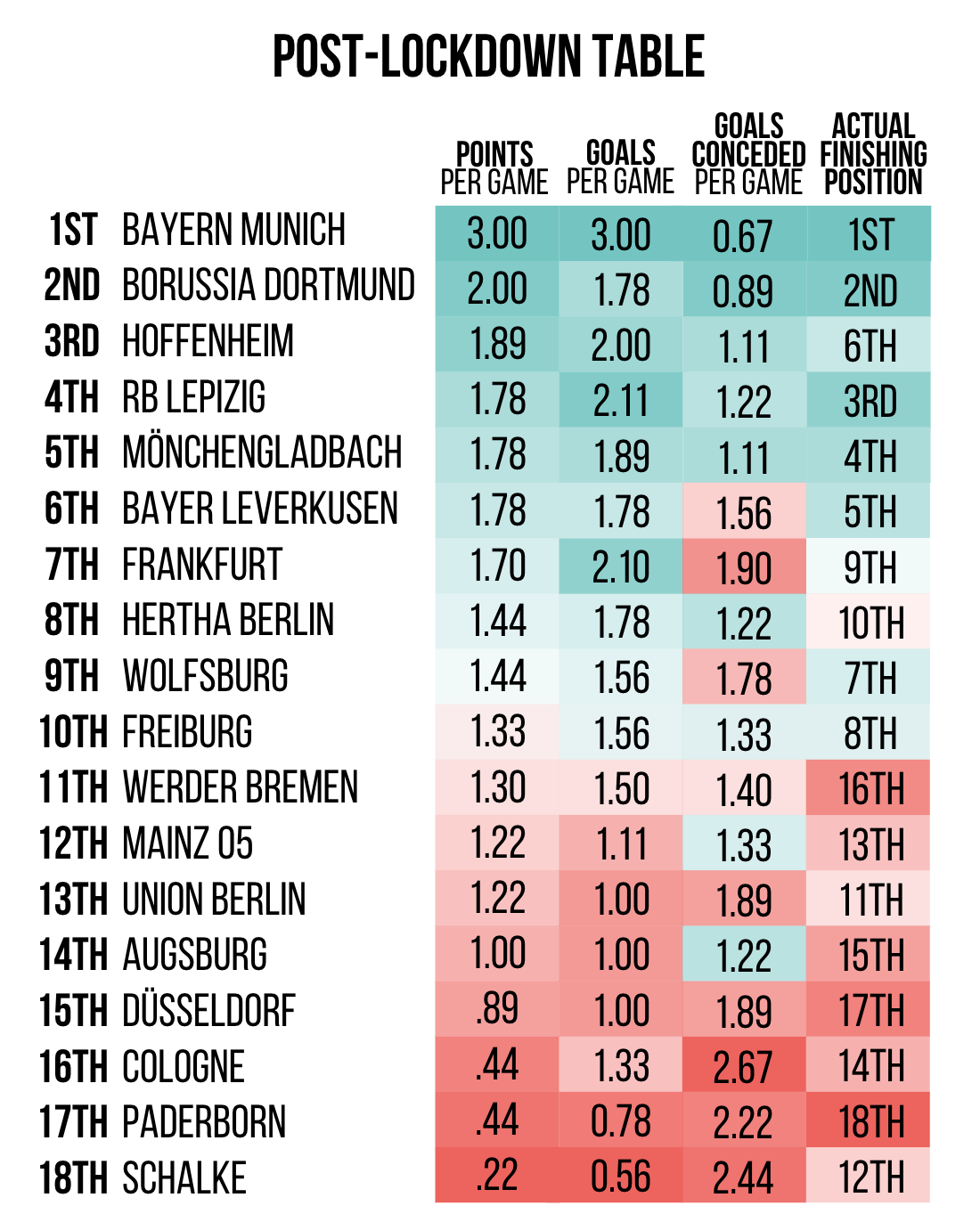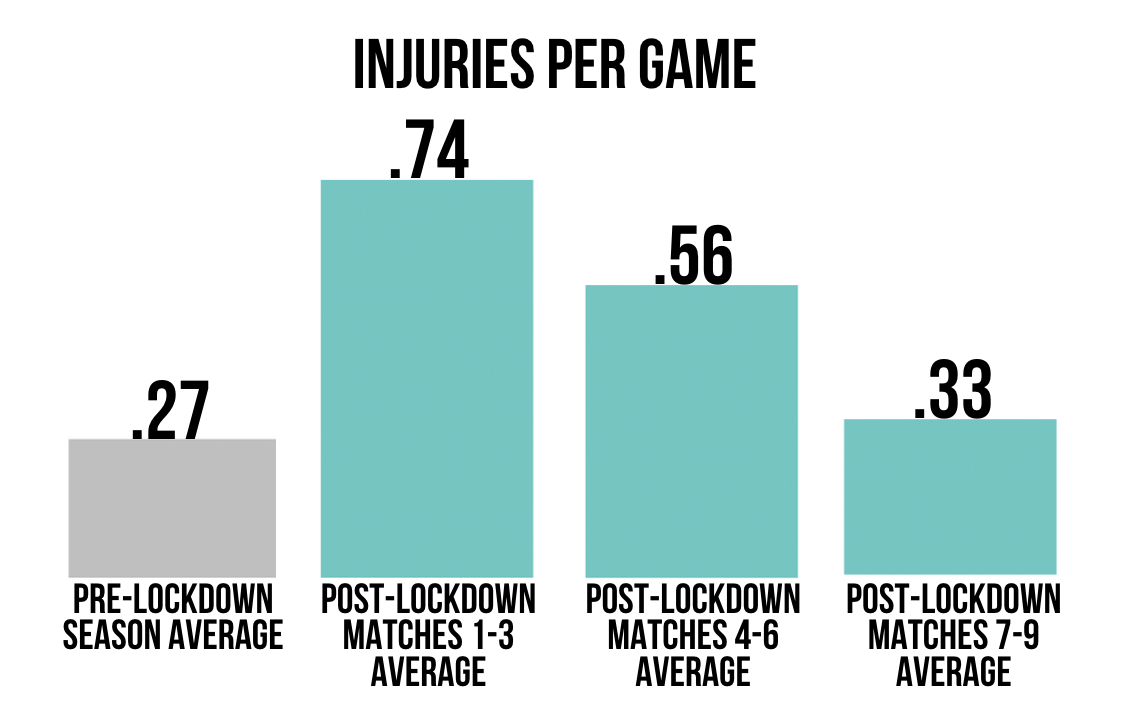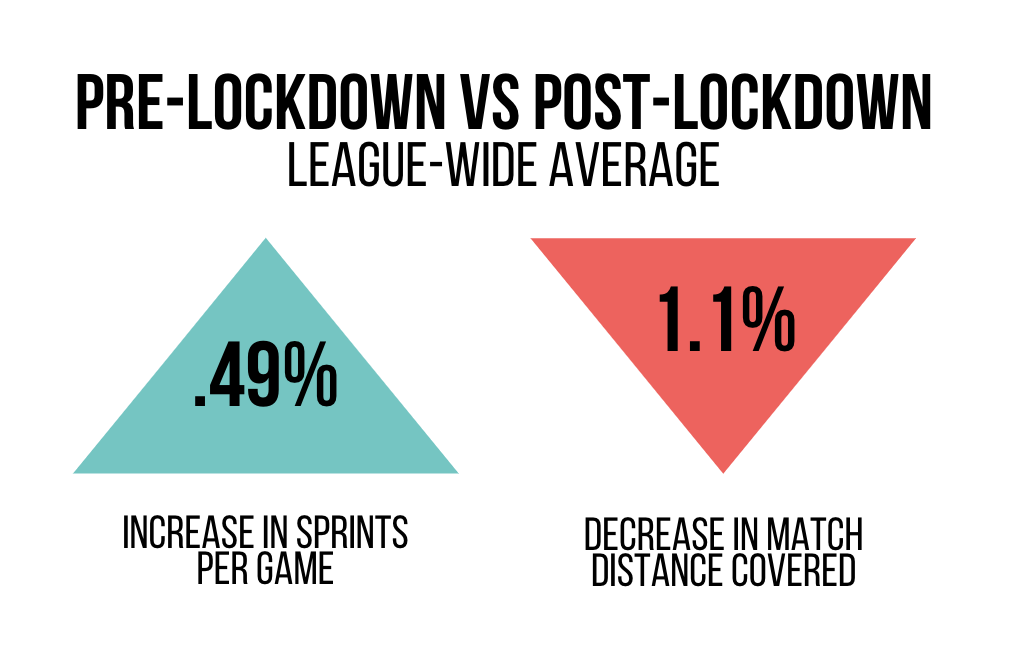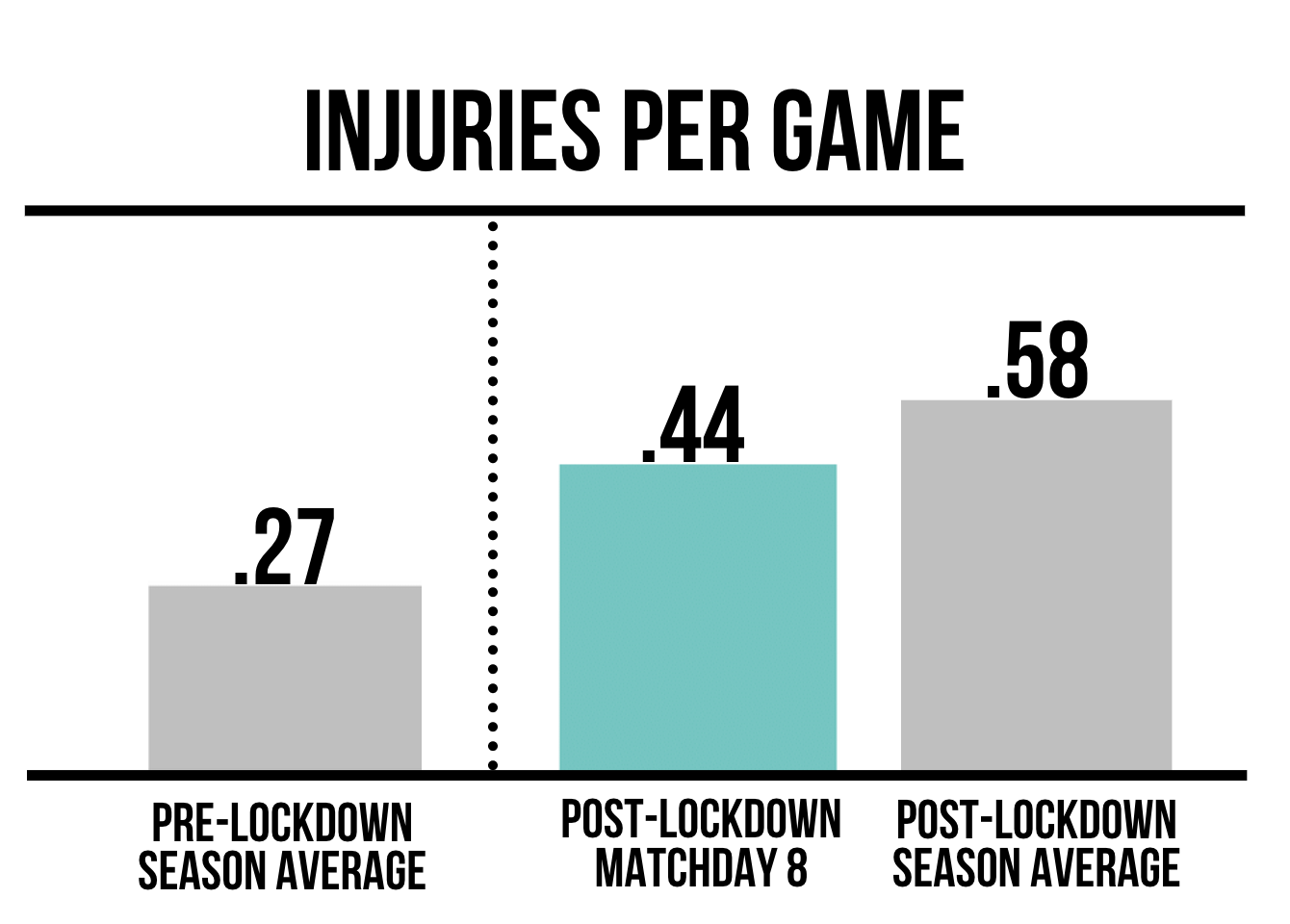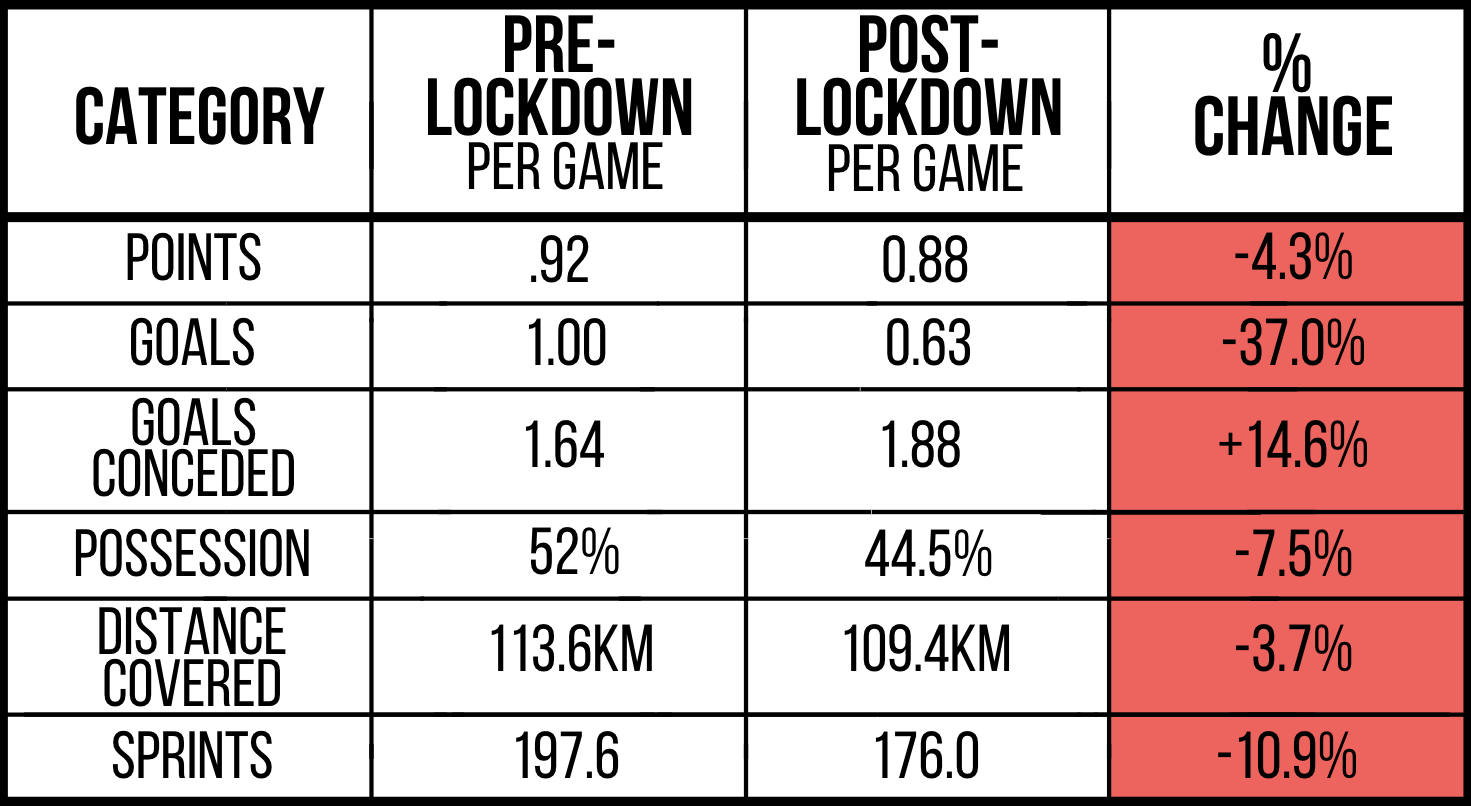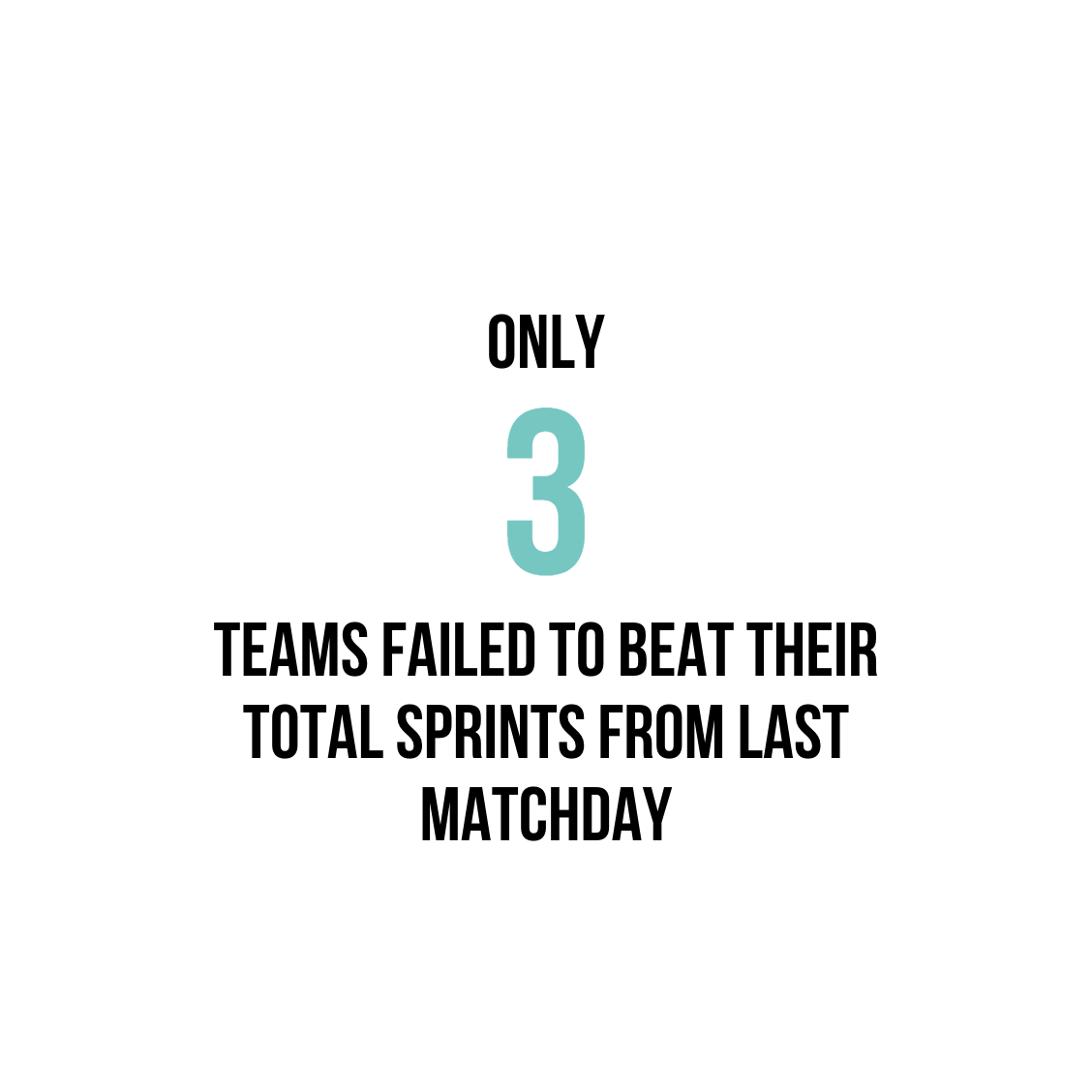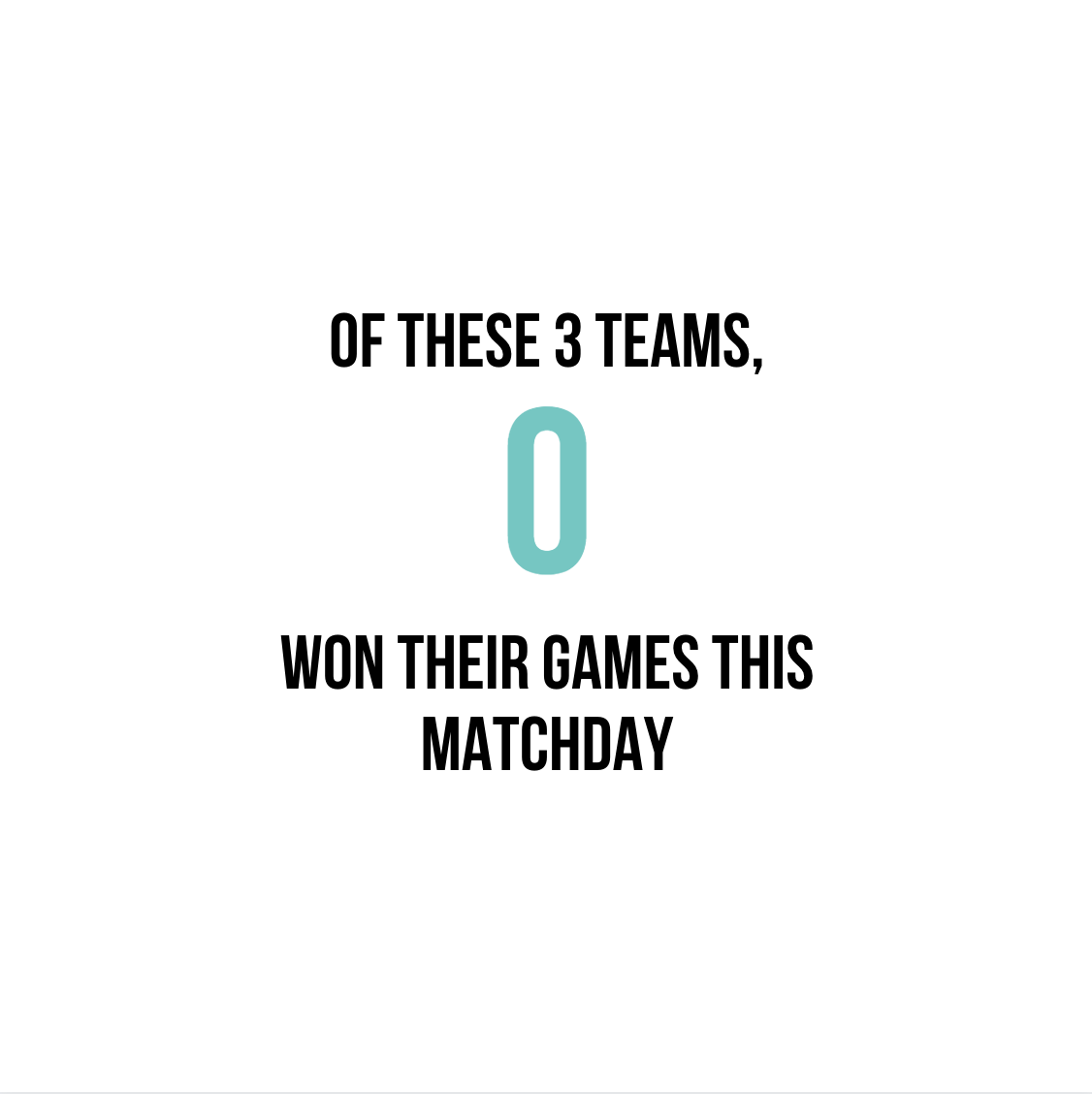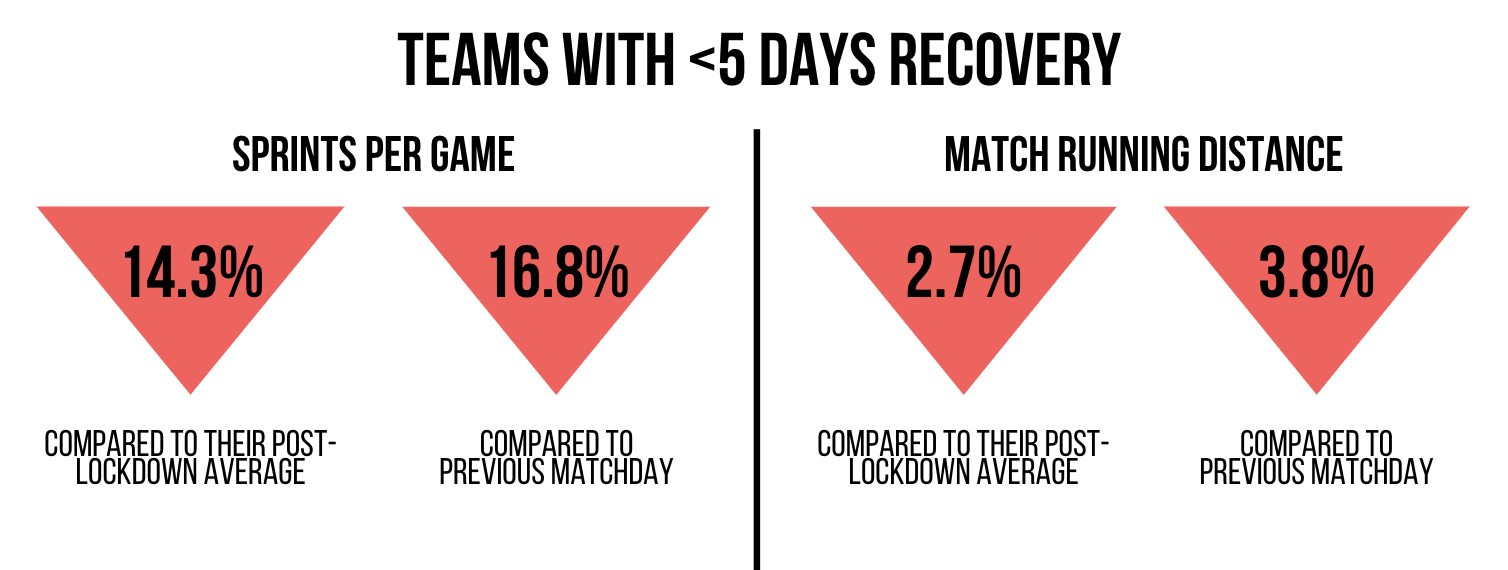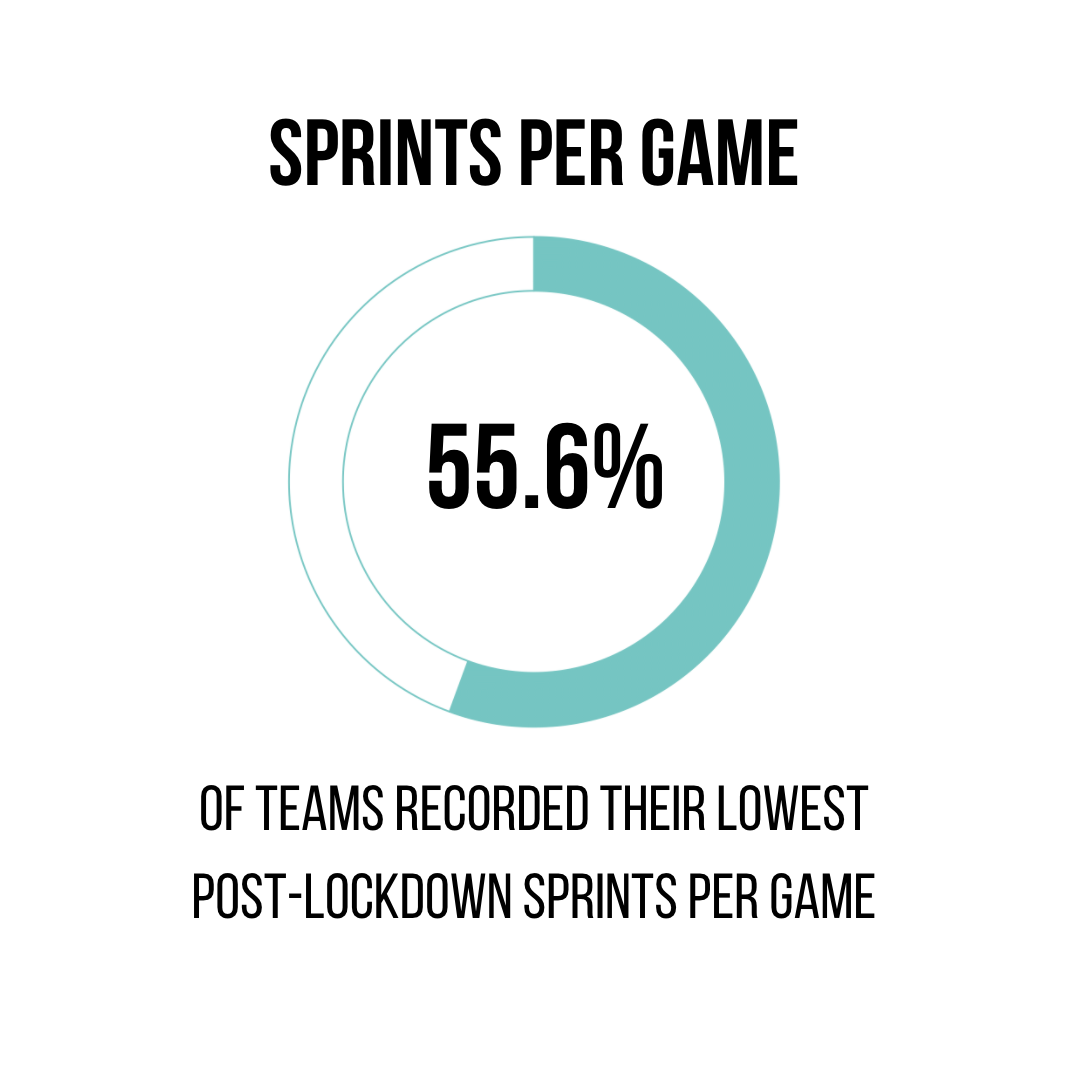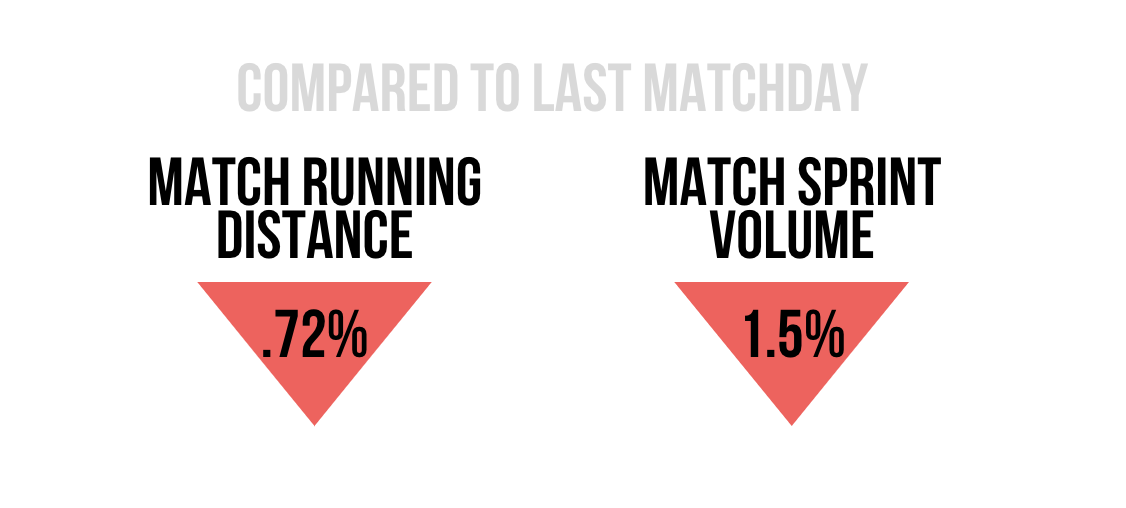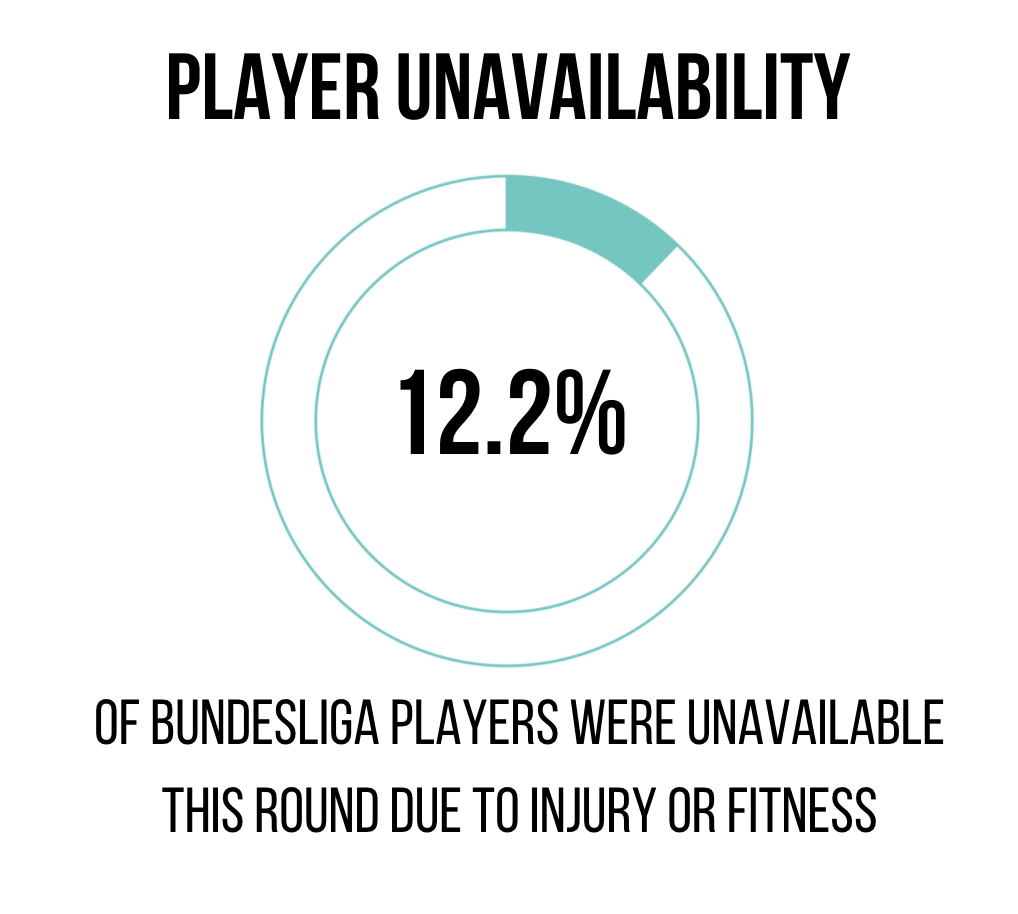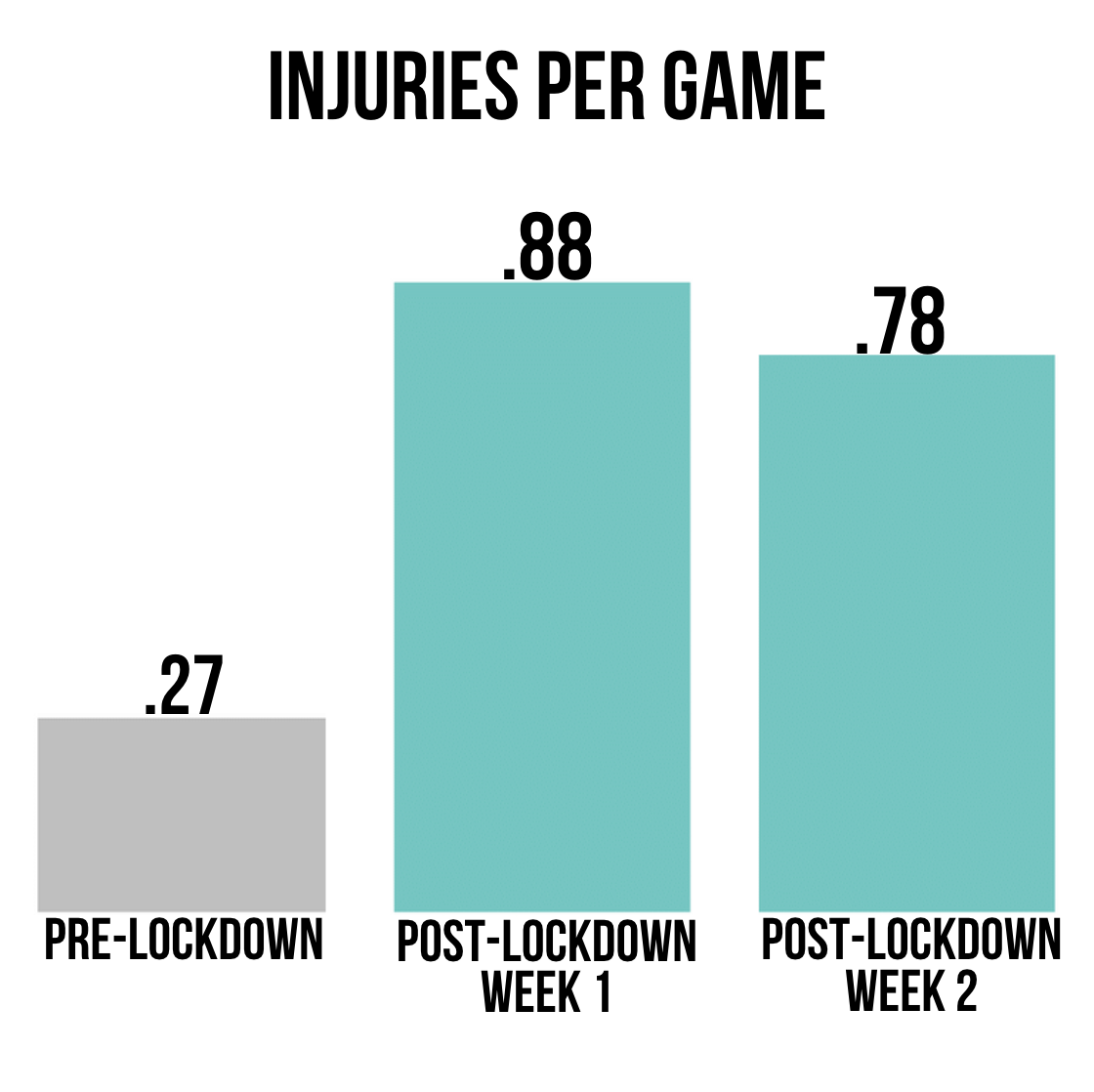German football was thrust into the global spotlight when the Bundesliga became the first major sporting league to return from breaks enforced by the COVID crisis. On Saturday, they became the first league to successfully finish a season too, and it was a suitably turbulent final round – 34 goals were scored, and Werder Bremen avoided automatic relegation by scoring 14.3% of their goals for the entire season in just 90mins. For one last time, we crunch the numbers on the injuries, the physical performance and the use of substitutes to tell the final story of the post-lockdown Bundesliga season.
With some surprising results over the final nine matchdays, the restart often felt less like the continuation of an existing season, and more like a new one instead. So what if the final nine games were indeed an entirely separate season? To get an indication of how things unfolded, we’ll start where the numbers matter most – on the scoreboard:
At the heart of the conversation since the restart has been the risk of injuries after such a limited and disjointed preparation. These fears were justified in the first two weeks of matches, with the news that match injury rates were substantially above the pre-lockdown injury numbers echoing around the world. So what’s the verdict now that the season is over?
If we simply combine the matchdays to produce an overall post-lockdown injury rate, it’s more comfortable viewing than the first two weeks – around .56 injuries per game, which could be considered within the upper boundaries of a typical Bundesliga season depending on the methodology used and which peer-reviewed evidence you consume. But just like a regular Bundesliga season, certain phases of the post-lockdown season carried a substantially higher risk of injury, which the overall average neglects to describe:
Injury incidence was significantly higher immediately upon the return to play, likely driven by the limited time and access to appropriate football loading, before progressively declining back to normal as players became accustomed to match loading again. But the way that injuries manifest is never linear, and playing more games can have divergent effects. The AFL, for example, managed to entirely escape an early injury increase in their first round, but in the third weekend of games, at least five players were removed due to hamstring injuries across just nine games. It’s likely that injuries will present uniquely in the other football leagues currently underway too – there have been 82 injuries reported in the EPL since the start of June, which sits above the average in a typical starting month of around 50. There are a range of factors mediating the post-lockdown injury risk across the world, including the length and severity of lockdown protocols and the corresponding access to contract training and practice games. The context of games matters too – EPL teams are accustomed to playing multiple games per week, whereas Bundesliga teams typically only play once per week, although teams with consistent European duties are more experienced in managing multi-game weeks, which may have contributed to Bayern’s ability to proceed as normal.
Simply calculating the rate of injury fails to capture the impact of time or value lost due to injuries, and so assessing the burden is perhaps more useful, and can even drastically change the story. Although insufficient data is publicly available to accurately characterise the burden of injuries in the post-lockdown Bundesliga season, there are preliminary insights at opposing ends of the scale. Firstly, of the eight players injured during the first week of matches, six of them were available for selection a week later. This captures the nature of the early injuries – a majority of them were minor issues causing less than a week of time-loss. On the flip side, teams were often missing important players which likely impacted their chances of success - for example, of the eight players awarded Bundesliga Player of the Month this season, six of them missed time due to injuries sustained since the start of May, including a season-ending knee injury to Schalke’s Amine Harit. Some teams struggled with player availability more than others:
The player unavailability table provides some crude insight into the situation teams were dealing with as they navigated the remainder of the season. It’s not necessarily a fair example of how successful teams were with their load management strategies for a number of reasons – 1) it includes some injuries sustained pre-lockdown, and 2) injury prediction is a road notoriously filled with potholes even under regular circumstances - at least one of the Bundesliga’s best teams has external statisticians working with machine learning models to predict injuries, and this team still sat near the top of the player unavailability charts.
On average, teams were roughly running just as much post-lockdown as they were prior to it. So how and why were they able to maintain their physical performance despite the circumstances?
1. The pause may have acted as a refresh for some teams and players, who were all at least 25 games deep into a long season. Top European sides who don’t have mid-season breaks lose around 303 more player-days per season to injury than teams who have a break, and although it’s a fine line between healthy time off and a rest that is too long, lockdown may have served as a timely opportunity for recovery.
2. Playing in close or important games is known to increase running numbers across most football codes, and there was still plenty to play for when teams finally emerged from the break. Dortmund and Munich were locked in another tussle for the title, a fair chunk of the table was still in contention for European spots, and most of those who weren’t in the European race were instead battling to avoid relegation.
3. The much-discussed substitution policy allowed teams an extra two changes to reduce the physical burden on their starters and provide a dose of fresh legs (outlined in the next section).
Combined, these factors may have galvanised teams, allowing them to approach the remaining nine games as a sprint rather than a normal stretch of games at the backend of a long season. But we know that absolute measures of running behaviour are poor predictors of match success at a team level. For example, the team with by far the lowest sprinting numbers was Hoffenheim, who impressed with a third-place finish in the post-lockdown table. Further, Schalke were ranked 4th in total sprints despite a dismal season, essentially eliminating the value of running metrics as fair indicators of match performance on the surface level. Instead, we can assess the team-by-team differences in running metrics pre- and post-lockdown to provide a more appropriate indication of how well teams were able to physically cope with the compromised preparation.
Exactly half of teams exceeded their pre-lockdown sprint performances. It’s no surprise to see Hertha Berlin, Werder Bremen and Frankfurt all posting >5% increases in sprints per game, with each of these teams jumping multiple places in the post-lockdown table. On the other end, Dortmund posted a 12.4% drop in sprints per game, but typically maintained possession dominance over their opponents regardless of running metrics. In terms of total running distances, most teams were within striking distance of their overall averages, but only five exceeded their pre-lockdown numbers.
The addition of two extra subs injected some life into the post-lockdown season, allowing managers the freedom to not only provide their starters with a physical reprieve, but to influence games through additional tactical switches as well.
Every club averaged more than three subs per game, and the concerns that better teams would harness the extra substitutes to widen the gap between them and the bottom teams didn’t quite eventuate - the bottom three teams all featured in the top 5 for substitutions made. Yet noticeable inter-team disparities emerged as the weeks rolled on, and even similar strategies likely held divergent motivations for certain teams. For example, Cologne implemented a particularly aggressive approach to substitutions, presumably in failed search of a solution to their disappointing post-lockdown season, but Werder Bremen and Hoffenheim also demonstrated a similar inclination for early changes, and both punched well above their weight following the restart. At the opposite end, Bayern were apparently still in first gear, averaging an equal league-low of 3.67 subs per game and using their first sub in the 64th minute – 14mins after Cologne typically employed theirs.
Wolfsburg sat alongside Bayern at the bottom of the substitutes table, but unlike Bayern, their substitute-shy approach may have cost them towards the end of the season. They were the only team to not use a single half-time substitute across the nine games, and they waited until the fifth game to use more than three subs. It’s little surprise that they experienced the second largest dip in total distance covered league-wide, and posted a restart record low of just 105.4km covered on the final matchday. It’s plausible that their substitution stubbornness is at least partially explained by a lack of appropriate options – they had the third worst unavailability in the league, with an average of 5.67 players missing per game. While Wolfsburg displayed a reluctance to experiment, Leverkusen showed no such hesitation, deploying a total of ten half-time substitutes in nine games, often in batches of two or three.
Away Advantage
A remarkable feature of Germany’s so ghost-games was the reversal of home advantage, which defied the odds to continue throughout the post-lockdown period:
A staggering 47.6% of post-lockdown games were won by the away team, whereas only 20.7% of games ended in a home team victory. The trend has been the subject of thorough analysis, and rightly so. But while the stakes were level across the Bundesliga season, with all games played behind closed doors, the situation in Australia will soon allow spectators in certain regions. The AFL’s proposed hubs in Western Australia, which would see interstate teams travel to play a series of games against local teams in front of up to 60,000 fans, have the potential to produce a rare Victorian-team disadvantage, as Melbourne clubs continue to play home games behind closed doors.
Injury-time Headaches for Hamburg
Second division side Hamburg took the late goals trend to the next level, but unfortunately for them, it was in the goals conceded column. After spending a record 55 consecutive seasons in the first division, the club was relegated in 2018. This year, with a return to the Bundesliga in their sights, they sat firmly in the promotion zone when the season was paused. But in the nine games since the restart, Hamburg recorded only two wins, drawing four matches and suffering three losses. Here’s where things get interesting - they conceded 18 goals in their 9 post-lockdown games, and 5 of these goals were scored beyond the 90th minute. That’s 27.8% of all their goals. And it gets worse. Most of these late goals cost Hamburg valuable points in their fight for promotion – including a 94th minute equaliser in a 2-2 draw, a 92nd minute strike in a 3-2 loss, a 93rd minute equaliser in a 3-3 draw and a 95th minute goal in a 2-1 loss to Heidenheim, who as a result of winning that game, leapfrogged Hamburg into the promotion playoff spot. It’s a statistically improbable phenomenon that will haunt the Hamburg goalkeeper and fans for at least the next year while they play out another season in Germany’s second division.
Overall, there were some clear winners and losers from the whole process. Paderborn were a predictably easy target, and sealed their relegation fate reasonably early. Yet by far the most underwhelming post-lockdown season came courtesy of Schalke, who were in sixth place when things were temporarily put on hold, and ended the season in 12th. If the post-lockdown season was a standalone one, they’d rank below even Paderborn and would be on their way to the second division. They posted a league-low goal difference of -24 across nine games, and had 5.89 players unavailable per match (second worst in the league) while ranking third-worst in the league for total subs used. But ultimately, the teams flourishing post-lockdown far outweighed the teams floundering. Beyond the obvious Bayern, who recorded a perfect record and topped the total sprints per game chart, a number of teams who had disappointing seasons prior to the break came out with a vengeance after the restart. Hertha Berlin employed a similar high-risk/high-reward strategy to Bayern, withstanding poor player availability to post a 10.9% improvement on their pre-lockdown sprinting volume to notch four wins in a difficult schedule. Frankfurt also nailed the process, ranking third in goals scored since the restart, leading the league in player availability and posting a 5.4% increase in sprints per game. Finally, Bundesliga royalty Werder Bremen posted an 8.4% increase in sprint numbers and wielded an active substitution strategy to climb out of the automatic relegation hole they seemed destined for. If the post-lockdown season was an independent one, they would have finished 11th, just over one game outside the European places – a far-cry from the 17th place they occupied prior to the pause.
So where do we go from here? The German cup final will be played on July the 4th, and both Bayern and Leipzig are still active in the Champions League. But it was never just about German football. With the AFL season still in its adolescence, the NBA to resume in late July and millions of sub-elites returning to sport across the world, it was about getting valuable information into the right hands in a timely, actionable manner that the traditional academic publishing model is often incapable of. Based on the response, the Bundesliga Blueprint was a story worth telling. Thanks for tuning in.
Only three clubs failed to score as Bundesliga teams spent the penultimate weekend of action jostling for position. Dortmund secured second spot above Leipzig, but the race for the remaining Champions League spot and to avoid relegation will go right down to the wire next week. In this edition of the post-lockdown analysis, we take a quick look into the injury rates and physical performance from Matchday 33, before taking a deep dive into the team worst-hit by match congestion:
Four match injuries were recorded this week to bring the overall post-lockdown injury rate to .58 injuries per game. Preliminary data from La Liga and the English Premier league also points in a similar direction to the early Bundesliga results – a substantial amount of minor injuries driving the overall time-loss numbers up.
Most teams played their third game in less than ten days, but there’s plenty still left to play for, and the ability to reasonably sustain physical performance is evidence of that. Although teams were 1.1% and .46% below the post-lockdown averages for sprints per game and total distance covered, these numbers are well within the typical range.
The Dresden Dilemma: a match congestion case study
Just because the early lessons from the Bundesliga have now echoed around the world, it doesn’t mean class is over. For those planning the return of sub-elite sport in the coming months, as well as the AFL who are now in a tight spot courtesy of Essendon, the case of Dynamo Dresden should serve as a cautionary tale.
Following lockdown, bottom-placed Dynamo Dresden were scheduled to return to action on May 17th alongside the rest of Germany’s second division teams. But following confirmation of two COVID cases on May 8th, their entire squad was forced back into quarantine for two weeks while everybody else got underway. They emerged from quarantine with just nine days to prepare for their first clash, and their three postponed games were rescheduled to mid-week slots between their existing fixtures. And so a post-lockdown experiment was accidentally born - a Dresden team, suddenly scheduled to play a game every 3.3 days (including a stretch of 7 games in 19 days for a game every 2.7 days), vs a control group of teams playing games every 4.9 days after more than double the preparation time.
To make things worse, Dresden have faced three of the top four teams in the last few weeks as they fight for second-division survival, and have played more than half of their games away from home, which adds the complexities of travel to their already compromised recovery. Although they slumped to three consecutive defeats without scoring, they claimed a second post-lockdown victory yesterday via a 90th minute winner to bring their tally to seven points from eight games. Mathematically speaking, they’re still a chance to make the relegation playoff spot, but it’s the longest of shots – they must win their final game by 15 goals and hope that Karlsruher are defeated. While Dresden’s post-lockdown plight for survival was doomed from the start, the situation has provided unique insight into the emotional and physical costs of severely limited preparation and a highly congested match schedule.
Injuries
If you’re a regular consumer of Trackademic, your first question will likely be about injuries - and rightly so, given the evidence surrounding periods of increased matchplay and increased injury rates. In under a month, five Dresden players have suffered injuries that have led to a time-loss of at least ten days each – two muscle strains, and three joint issues. At least three further complaints have also caused minor time loss, but the impact of the situation runs deeper than injuries.
Game and physical performance
Dresden’s struggles to find the back of the net existed long before the lockdown, but have been accentuated following the restart, suffering a 37% dip in goals per game. And, despite doing a better job of maintaining their comparatively good defence, their control over games has been limited, dropping 7.5% and 8 places to rank 15th in the possession stakes.
Prior to lockdown, Dresden outsprinted their opponents in 52% of matches. Post-lockdown, they’ve outsprinted their opponents just once in eight games (12.5%) to sit 14.5% below the league average. Similarly, pre-lockdown, they were covering more distance than their opponents in 20% of games, but since the restart, they’re yet to outrun their opponents, hovering 4% below the league average. Despite being ranked 13th and 14th in these measures pre-lockdown, they’re now ranked 18th and 17th respectively since the restart. It’s clear that Dresden are physically suffering from the tight schedule, and so it comes as little surprise that 48.5% of their substitutes have been made prior to the 70th minute, in an attempt to overcome the burden on their players.
To be fair, Dresden were already sitting in last place when the season was paused. But against all odds, they’re actually accumulating more points per game than two other clubs since the restart. And even if it wasn’t always evident on the scoreboard, pre-lockdown they were showing promise in a number of categories. But the early-season advantages Dresden enjoyed in the possession and sprinting metrics have since been abolished by the combination of a drastically limited preparation and a uniquely packed schedule, and they now sit at or near the bottom of the league in all post-lockdown stat categories. Due to the situation, they’ve been robbed of an equal chance to fight for their existence in the second league, and they know it – threatening legal action against the DFL when they are inevitably banished to the third division. However, the other option available to the league – which would have seen the season lengthened to avoid match congestion, thus leaking into an already shortened pre-season for the following year – was complicated by players and staff coming out of contract on June 30th.
While there may not be an easy solution in Dresden’s current situation, it’s not too late for amateur sport leagues to learn from the experience as they plan to resume in the coming weeks and months. If the professionals and their world-leading sport scientists are battling to manage the load appropriately, especially when games are packed together, then juniors, amateurs and weekend warriors will struggle with the return demands too – as highlighted in the initial Bundesliga Blueprint. Unfortunately, the desire to fit in an appropriate amount of games prior to a certain date often wins out over health concerns – for example, amateur Gaelic football players are facing four games in a ten-day period upon their restart, according to leading physio Marty Loughran. The return of amateur sport is of course a welcome one, but calculated measures need to be taken to ensure people are finishing their seasons in one piece.
A dilemma similar to Dresden’s is also emerging in Australia, after Essendon’s Conor McKenna tested positive for COVID-19 on the weekend. Their clash with Melbourne was immediately postponed, but all other games in the league went ahead as scheduled. At the time of publication, the latest suggestion is that Essendon’s next game against Carlton will proceed without at least five key players who have since been quarantined due to their classification as ‘close contacts’ with McKenna. There are a couple of minor wins for the AFL here – the decision to release the remaining fixtures in smaller batches rather than all at once allows them the space for agile planning, while the strict enforcement of small training groups early after lockdown may preclude the quarantine of the entire Essendon squad. But Essendon will ultimately be at the mercy of the Victorian Department of Health, and given the rise in cases over the past week in Melbourne, it wouldn’t be a surprise to see more players quarantined and more games postponed. This would leave the AFL at a similar crossroads as the German football league were at a month ago – make the season longer, cram Essendon’s schedule, or simply cut the amount of overall games to be played? If they choose to have Essendon play mid-week catch-up games, the demise of Dresden has given us some insight into what could eventuate. If the first half of 2020 is anything to go by, we should expect the unexpected.
Matchday 31 saw more heroics from Håland and a bold Bremen signal their intentions to stay in the top flight with a 5-1 thumping of Paderborn. But Bayern Munich had to rely on an 86th minute winner to scrape past Mönchengladbach in an uncharacteristically sluggish game that captured the essence of the round. For the first time since the restart, there was a substantial drop in league-wide physical performance, with teams who played an extra game during the week due to cup fixtures suffering more than others. Although injuries remained in the normal range for the second week running, Leverkusen boss Peter Bosz highlighted the toll that the limited preparation is taking on his squad, describing how his players “…never complain about muscle pain after training sessions, but suddenly they do…”, before continuing to detail their struggles - “…Do you want to know how many players are doubtful for the next match every week? Almost all 11”. Bosz isn’t the only coach having issues – Dortmund manager Lucien Favre injured his calf while celebrating his side’s 95th minute winner against Düsseldorf. For the record, Favre’s incident was not counted in the overall injury tally for this week. Key insights from Matchday 31 include:
Abroad
After 28 training injuries in 20 training days (including 19 soft-tissue complaints), Spain’s La Liga got underway in predictable fashion with Messi finding the back of the net and a number of key players subbed off with minor issues, including Sergio Ramos and Eden Hazard. The AFL mostly avoided a similar fate upon their return, with a distinct lack of in-game soft tissue injuries reported. This is likely a product of the easy targets being weeded out through training injuries, the decision to reduce quarter lengths by four minutes, the pause in season occurring after a single round rather than 25-games deep like the Bundesliga, and perhaps simply sensible loading strategies after keeping an eye on the Bundesliga Blueprint. Some fans who were begging for the resumption quickly changed their tune on opening night, complaining simultaneously about the quality of the game and the shortness of the quarters, as Collingwood and Richmond played out a low-scoring draw. And just when you thought 2020 was running out of curveballs, St Kilda, Essendon, North Melbourne and the Gold Coast all collected wins over the weekend.
The Forecast
There’s no shortage of upcoming action, with the return of the English Premier League on Wednesday night and a La Liga game scheduled every single day between now and July 19th. It’s little surprise that injuries are projected to skyrocket in the Spanish League, although it is worth noting how unsuccessful injury prediction can be, no matter how big the data is. With physical performance inevitably slipping and another mid-week matchday looming on the horizon, it looks likely to become the survival of the fittest for the three remaining Bundesliga rounds.
For the first time in the post-lockdown season, the matchday injury rate dropped back within the normal range observed during a typical season. It’s also worth noting that the severity of match injuries over the last four weeks has been lower than widely anticipated, with a large number of players suffering time-loss of under a week. While both of these feats are cause for celebration, the training injuries continue to roll in, including at least five fresh muscle complaints causing players to miss time across the Bundesliga this week. Abroad, none other than Leo Messi headlines the injury list, and Juventus striker Higuaín is the latest addition to the ever-growing post-lockdown strained hamstring club.
Substitutions
A central aspect in limiting the physical burden on Bundesliga players has been the addition of two extra substitutes per team. The decision to adopt the same policy for the remainder of the English, Spanish and Italian seasons has sparked fears that the gap between good and bad clubs (and rich and poor clubs) could widen as a result. On the flip side, Barcelona manager Quique Setien claims that the rule change nullifies the fitness advantage that his squad has over other La Liga teams. For some insight into this dynamic, we took a look at how Bundesliga teams have been using their subs, how much value the substitutes are providing, and if there’s any disparity between the top and bottom teams.
There’s a clear positional bias in the substitutions being made across the post-lockdown games. While it makes sense that teams are emphasising the rotation of their midfielders given their high mileage, coaches are also heavily favouring the rotation of strikers over defenders. To be fair, the priorities have actually been slightly more balanced since the rule change - across the first five regular rounds of the season, 9% of players subbed off were defenders, 54.7% were midfielders and 36.3% were strikers. But the gap remains, and the tendency to allow increasingly fatigued defenders to face off against fresh-legged strikers likely contributed to the amount of goals scored during the closing stages of games this week:
If we relax the time threshold just a little further to include goals scored after the 75th minute as well as those scored between the 40th and 45th minutes, the fatigue factor becomes even more compelling – goals scored in these time periods accounted for 47.6% of all goals scored this week.
Since the restart, lower-ranked teams are getting more mileage out of their substitutes than top teams, including more minutes played, more distance run and more sprints completed overall. Even when the running metrics are scaled to per minute stats, the lower teams still come out on top. So what’s driving the difference in output? It could be interpreted as bottom teams doing a better job of rotating their line-ups, and this will likely come in handy over the final weeks of the season. It’s also plausible that the top teams believe they don’t need to go the extra mile to relieve the burden on their starters because they have confidence in their preparation and performances. Indeed, the better teams may be approaching the substitution game as though it’s just a regular season – Bayern Munich and RB Leipzig have only used five substitutes once each in their combined ten games post-lockdown, and 52% of Dortmund’s subs have occurred from the 80th minute onwards. Further, the willingness to use subs and the effectiveness of subs are different things. While lower teams are effective in reducing the physical burden on their starters, the top three teams are comfortably ahead in the metrics that are closely aligned with match outcomes, such as goals and assists, despite playing less minutes. There’s also a clear difference in the average market value of the subs, and although this is only based off of estimations from the trusty transfermarkt.com, it’s enough to indicate a difference in class. The outcome is perhaps not as bleak as expected, but the subs from the top teams have left a more observable mark on games than those from the bottom teams, in a classic battle of quality vs quantity.
League Average Physical Performance
The drop in injury rate wasn’t the only thing to write home about this weekend, as there were also improvements in league-wide physical performance averages. Four teams recorded their post-lockdown season highs in sprinting, and the overall league-wide average was eclipsed by 3.6%, which was also accompanied by a slight uptick in distance covered.
The Forecast
Although the title race appears to be sailing towards a predictable conclusion, the battle to avoid relegation is far from over. Beyond the league, one of the highlights of the season continues tomorrow as fourth division side FC Saarbrücken face off against first-league powerhouse Bayer Leverkusen in the German cup semi-finals. The plucky underdogs from the south-west have won two games courtesy of injury-time winners, survived two penalty shootouts and defeated two top-flight teams on their way to the final four. In a captivating twist, their own league season has been cancelled due to the pandemic, meaning they’ve had months to prepare for a single game – or perhaps two, if they can get past Leverkusen, who will be without Kai Havertz due to injury. Elsewhere, both the Spanish La Liga and Australian football are set to get underway this week, with North Melbourne coach Rhys Shaw proudly proclaiming that his team had been ‘flogged’ on the training ground over the break. This might be the kind of old-school attitude that has seen his side linger around the top of the injury table thanks partly due to three training injuries in as many days late last month. Although the Bundesliga will no longer be alone in the spotlight, the lessons from German football clearly aren’t over yet.
The Frauen Bundesliga made a welcome return to action over the weekend, while the second-division Bundesliga continued to provide a weekly dose of stoppage-time winners. In the Bundesliga, the substitution allowance again helped teams to almost maintain their physical performance, but injury numbers crept back up. And it’s not just the players suffering from match congestion, but the sport scientists too - so this week, we’ll let the numbers do the talking:
This week saw teams battle fixture congestion for the first time post-lockdown, with just 72 hours to recover from their previous bouts. Despite the short recovery window, there was only a slight dip in overall physical performance league-wide that’s well within the normal boundaries of the variations observed in a standard Bundesliga season. However, the number of teams recording post-lockdown lows in total running distance and sprints provides some deeper insight.
50% of teams recorded their lowest post-lockdown running distances, and none of these teams won their games this week. Further, 38.8% of teams also recorded their lowest post-lockdown sprint totals too, and similarly, none of these teams won their games this round either. It’s a fascinating takeaway that cautiously links drops in physical performance with unsuccessful results, but it’s important to keep in mind that total distance covered and sprints aren’t the most reliable indicators of match success. After all, Bayern’s opponents tend to exceed their respective sprint averages on their way to defeats, as we highlighted last week. But it’s plausible that relative markers of GPS are currently a little more aligned with match performance than they are under typical circumstances, due to the gaps in player preparation. It’s also important to note that four players this week opted for some early rest via red cards, which very likely skewed the average GPS data.
Injuries
As predicted, the injury rate continues to slide back towards pre-lockdown numbers. But it’s got some way to go yet, and as fatigue accumulates throughout the season, it may never quite lower to normal levels. The early wave of soft-tissue injuries from training camps and early matchdays appears to have slowed, and has been largely replaced with contact and structural injuries. We’ll take a look at the relationship between limited preparation, fatigue and both contact and structural injuries in a future edition of the blog.
The major news this week was a knee injury to wunderkind Erling Håland, adding to the availability woes of Dortmund. Due to the extremely limited opportunity to introduce training load between matches, very few training injuries have popped up since the last post, although Bayern’s Lars Lukas Mai went down with a potentially serious ankle injury today.
With the first major hurdles overcome, there’s no better time to take a quick dive beyond the league-wide averages to investigate the early winners and losers from the post-lockdown season.
The Early Overperformers
1. Bayern Munich
Is it any surprise to see Bayern top this list? The perennial overachievers continue to be consistently brilliant (and brilliantly consistent). With one of the best at the helm of their sport science department in Dr Holger Broich, they’ve got a clear lead in post-lockdown sprint volume, sitting a staggering 20.9% above the league average. Joshua Kimmich even covered a club-record 13.73km against Dortmund, and although though they haven’t entirely escaped the injury influx, it’s been business as usual for the best. They’ve scored eight goals in three games, and calmly survived the challenge from their closest threat. All signs point towards Bayern coasting to an eight-straight league title with trademark composure.
2. Hertha Berlin
Emerging from the lockdown with a new head coach, Hertha have been a surprise packet in the post-lockdown season, with convincing victories against Hoffenheim (3-0) and cross-town rivals Union (4-0), before holding third-placed Leipzig to a draw away from home (2-2). They’ve exceeded their season average sprint totals in all three post-lockdown games so far, 4% ahead of their own pre-lockdown average. Although they’re currently managing at least four ongoing injuries, things are looking up at the Olympiastadion.
3. Werder Bremen
Despite an early 4-1 defeat against Leverkusen, Werder’s fight for top-flight survival has been a brave one, defeating Freiburg 1-0 and managing a draw against a Borussia Mönchengladbach outfit looking to secure a Champions League spot, both on the road. Bremen have hit the ground running in their post-lockdown games, posting a 17.3% increase in sprints and a 3.7% increase in total match distance compared to their pre-lockdown averages. With a game in hand and a reasonably favourable draw (aside from a clash with Bayern), they’ve got a real chance to climb out of the relegation zone if they can stay on top of their injury list.
Finally, a special mention to bottom of the table Paderborn, who are strangely undefeated in the post-lockdown season, although they’ve only scored one goal and picked up three points across three straight draws. A clash with Dortmund this coming weekend will likely bring their post-lockdown honeymoon to an abrupt end.
The Early Underperformers
1. Hoffenheim
Although they started on the road to redemption with a 3-1 win over Cologne last night, Hoffenheim have posted some miserable numbers on their way to a draw with bottom-placed Paderborn and a 3-0 defeat to Hertha Berlin. They’re 22% below the post-lockdown league-wide average for sprints per game, sitting comfortably in last place for this category.
2. FC Union Berlin
After shocking some pundits with a promising start to their first Bundesliga season, Union are now struggling to maintain pace, scoring just one goal in their past three games. Their running distances and sprint totals have both been getting progressively lower with each match, and their last two games were 13-15% below their own pre-lockdown sprint averages, landing them in the bottom two teams league-wide. The decision to use only two substitutes in their draw with the struggling Mainz highlights that squad depth is an issue, likely exacerbated by the ongoing management of a number of soft-tissue injuries within the team.
3. RB Leipzig
Despite a relatively short injury list, Leipzig haven’t been convincing, dropping precious points and losing contact with their slim title ambitions. They bounced back from a 1-1 draw against Freiburg to thump Mainz 5-0 away from home. But when they were presented with the opportunity to leapfrog Dortmund into second place, they were held to a 2-2 draw at home by Hertha. Their physical performance has been gradually sliding downwards every match post-lockdown - they’re covering 5% less distance than their pre-lockdown average, and they’ve only made use of their full substitution quota once, which came in their blowout win against Mainz. Due to a favourable draw for the road home, they’ll likely overcome an injury to captain Yussuf Poulsen to find some rhythm soon.
Some might also consider Dortmund to be underperforming, given their well-documented injury struggles, and their physical output may support this argument - they’re 15.8% down on their pre-lockdown average for sprints per game. But prior to their top-of-the-table match up, they’d banged in six goals without answer in just two games. Considering their limited player availability, losing by a single goal to the Bayern juggernaut could almost be seen as overperforming. Dortmund’s cautious approach to the management of loads for players with minor soft-tissue concerns may pay off in the back-end of the season, and it’s likely that as their player availability increases, they’ll be ready to pounce if Bayern stumble on the road home.
The Forecast
A quick look at the availability lists ahead of the upcoming fixtures paints a dire picture of the overall injury situation. Beyond that, teams are struggling to find rhythm, and the quest to balance recovery and meaningful training load following the first congested fixture won’t help that equation. We may see some delayed effects of the congestion over the coming weekend, as teams play their third game within a 7-9 day period. Elsewhere, as other leagues ramp up their training for returns of their own, injuries are accumulating. Big name AFL players who have suffered from soft-tissue injuries, such as Buddy Franklin and Adam Treloar, have been joined on the sidelines by Richmond rookie Noah Cumberland, who ruptured his ACL in training on Thursday. The AFL has also seen an exponential increase in the number of atrocious haircuts following lockdown, but I’ll let somebody else run the stats on that one. Unlike the mullets, the potential for a sharp increase in injuries won’t be a shock to teams or their staff as they plot their returns. The critical thing is how they choose to manage it in order to minimise the injury risk while maximising performance. We’ll be watching.
After significant interest in the exploration of load, injuries and the return of the Bundesliga last week, it would be an injustice to not keep tracking the numbers as the post-lockdown season unfolds. After all, early insights from the return of German football could prove pivotal in the successful return of other leagues. As the season rolls on, expect this post to provide weekly insights on GPS figures and injury rates in a bid to capture the physical performance dynamics of the post-lockdown season. Without further ado, here’s some key insights from week two of the Bundesliga resumption:
Physical Performance
Compared to last week (and pre-lockdown season averages), there were inconsequential shifts in league average match distance covered and match sprint volumes. Importantly, both of these variations are within the typical fluctuations of a regular top-flight football season.
As last week revealed, preserving dynamics of the game can be accompanied by a high injury rate. But there are also a range of contextual factors that interact with GPS metrics that need to be considered when interpreting these stats. For example, chasing around a ball-dominant opponent like Bayern Munich, who are averaging 63.5% possession in the post-lockdown season, can cause teams to operate at a higher intensity than they’re accustomed to. Both of Bayern’s post-lockdown opponents have eclipsed their season-average match sprint volumes by a sizeable 16.4% (Union FC) and 18.1% (Frankfurt) on their way to comprehensive losses. Close games also tend to produce an uptick in match dynamics, and over the last two weeks, 78% of teams playing in games decided by a goal or less exceeded their season averages for sprint volume. In a season with limited preparation, teams playing in a higher volume of close games may be at a disadvantage, as their cumulative match running loads drift upwards throughout the remaining weeks. A final consideration is a tactical shift associated with a change in coach, evidenced by teams emerging from the lockdown with new head coaches posting sprint volumes above their season averages in 100% of their games so far. Although there are likely more stories bubbling away beneath the surface, teams have so far been able to maintain their pre-lockdown outputs for two weeks running.
Injuries
Much to the delight of the sample-size crusaders of Twitter and Reddit, there are now more data points to add to the post-lockdown injury equation. In the first week post-lockdown, .88 injuries occurred per game, a dramatic increase from the pre-lockdown season average of .27. The second post-lockdown week saw .78 injuries occur per game, totalling a post-lockdown average of .83.
Some may argue that the early influx of injuries could simply reflect typical patterns associated with a return to matches after an extended break (such as off-season), and that this pattern is largely unrelated to the length or quality of the preceding physical preparation period. Indeed, injuries do naturally happen at different rates based on the stage of the season, but training injuries appear to peak early in the Bundesliga season, while match injuries tend to peak later in the season. Regardless, to generate a comparison point for the post-lockdown return, we analysed the first rounds of the last few Bundesliga seasons in order to assess the typical injury rates following an off-season layoff. The results speak for themselves - an approximate average of .37 injuries per first round match. Although this is an increase on the overall 2019-2020 season-long average, it pales in comparison to the post-lockdown numbers.
Outside of match injuries, the training ground injuries continue to accumulate, with one season-ending injury and at least six further injury complaints arising from across the Bundesliga over the four days between rounds. We’re now seeing similar trends in Italy and Spain as teams resume group training. In the last week alone, an anterior cruciate ligament rupture, a complete rectus femoris tendon tear (requiring surgery) and multiple meniscus tears and ankle sprains have been reported alongside a string of minor soft-tissue injuries. Not even Zlatan Ibrahimovic could escape harm, suffering a calf injury that was originally feared to be a season-ending Achilles injury in training on Monday.
While the sample sizes are obviously still limited and inconsistencies in injury reporting create an imperfect model, the evidence is quickly accumulating, and the early indications from both training and matches continue to point in one direction – that post-lockdown injury rates are comfortably outside the boundaries of the typically observed injury rates. When combined with the impact of the NFL lockout, as well as substantial multi-sport evidence of the injury risks associated with rapid spikes in load, the snapshot becomes a story worth listening to.
However, don’t be surprised if Bundesliga injury numbers slide back towards pre-lockdown measures soon, as teams find their rhythm, coaches adjust the load appropriately, and easy early injury targets (i.e. players or teams who mismanaged load during or immediately following the lockout) are removed from the equation.
The Forecast
Across the first two post-lockdown rounds, there have only been two home-team victories in 18 matches. Whether that’s a sign of the home ground advantage being cancelled out by the absence of fans remains unclear, but it’s just the sort of unpredictability that might sustain the attention of the sporting world even when more popular leagues return in the coming weeks. For now though, any Bundesliga teams hoping to catch their breath after the first two weeks of play are out of luck, as the first major hurdle in the form of a mid-week round arrives on Tuesday. The fixtures, headlined by a championship-defining clash between Bayern Munich and Borussia Dortmund, leave most teams just a 72-hour recovery window between their last game and the next. Given that full recovery from football matchplay can take up to three days even under regular loading circumstances, we can expect to see some teams struggle. Keep an eye out for continued updates, as the snapshot becomes a story.

